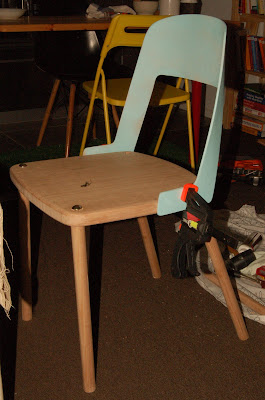
The chair legs appear longer >> narrow camera angle ( I guess...)

Legs >> 30mm dia Tasmanian Oak ( Danish Oil finish)
Back Rest >> 3 layer 1.5 mm Bending Plywood (Spray putty, sanded down to create (modern) rustic look)
Inspiration >>
Composition of intersecting basic geometric shapes in Zaha Hadid's Vitra fire station, interpreted into organic language of Frank Lloyd Wright's Guggenheim museum.
Basically, the seat comes in 3 main components >> Seat + Back rest + Legs 4X.
All of the components are removable, which will fit in 50 x 50 x 15 box.
Considering box size from the brief (50 x 50 x 50 cm), I decided to get the chair in to 2 components >> Back Rest + Seat with legs attached for the easy assembly.































































